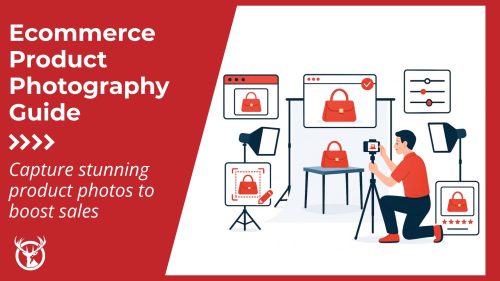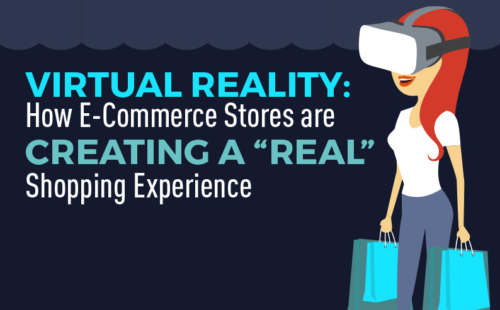Ecommerce packaging is an opportunity to personalize your shipments. The optimal unboxing experience involves a mix of the right box and the right infill—but it’s also a great chance to incorporate your custom branding. If your business is committed to being eco-friendly, packaging is also an effective way to demonstrate these values. These small details take product packaging from an everyday delivery to a truly custom package.
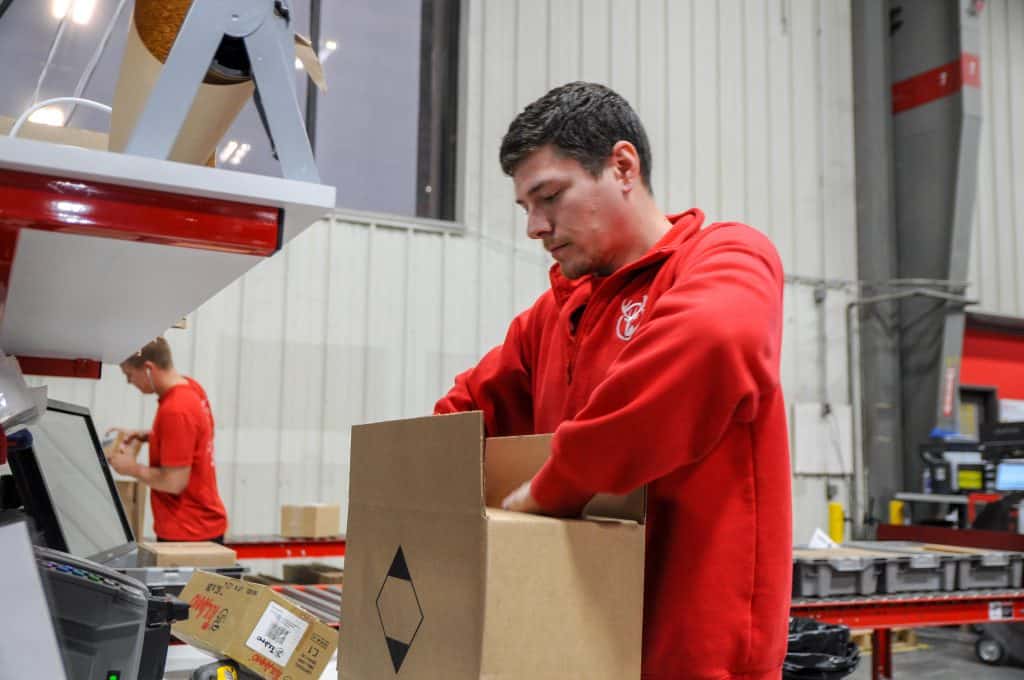
What is eCommerce packaging?
Ecommerce packaging is how you protect your product, establish your brand identity, and control shipping costs. It can enhance your customer’s experience and improve your profitability.
Packaging includes the box, any infill you use when packaging products, and inserts like tape and coupons. If your product ships inside its standard retail packaging—which is typical for products like furniture—you should also consider it your ecommerce packaging.
How should I package my products?
Your packaging material choices will affect your production and shipping costs. Weight and costs are important considerations because a product’s shipping expense can increase as boxes or infill become heavier.
Learn more about size and cost relationships with our DIM weight calculator.
Packaging and infill can impact ecommerce businesses in another way: returns. A well-packed order typically arrives in perfect condition. But packaging that can’t survive the delivery process can lead to damaged goods and disappointed customers.
Your package design can also enhance your customer’s experience and improve your profitability. Understanding your options is essential to making the best choice for your business.
Determining the right packaging for you
First on the list is the box or bag in which all your products will be packed. It’s what your customer will see first when they look in their mailbox.
Branded packaging may be worth the price if it creates a memorable experience (especially because some people reuse their boxes). As the number and types of products shipped via ecommerce have grown, so have packaging choices.
The type of packaging that best suits your products depends on several factors:
-
Weight: For heavier items, a sturdy box is needed to ensure safe delivery.
-
Breakability: A fragile product, even if it’s lightweight, needs protection during shipping.
-
Product value: When you ship high-value items, spending a bit extra on protective packaging can be a good investment.
The cost of packing materials can vary greatly, depending on type and quantity. If you outsource your shipping, you’ll pay for your ecommerce packaging through your 3PL services provider.
Your fulfillment warehouse is a volume purchaser of cardboard boxes. Even with a markup, you’ll probably pay less for packing supplies through your 3PL or fulfillment center.
Environmental impact and branding
Today’s top ecommerce brands have a wide range of packaging options to choose from, and we’ll dive into many of those shortly. One element we’re encouraging you to think about now is the direct connection between your packaging and your branding.
Many retailers and consumers have become more environmentally conscious and make some purchase decisions based on a company’s eco-friendliness. Choosing such options for your packaging has the potential to impact that first sale and follow-up purchases.
If customers notice you don’t use sustainable packaging, they may look elsewhere. Likewise, they may purchase again from you because they appreciate your eco-friendly packaging.
Eco-friendly packaging options
Using eco-friendly packaging made of recycled, recyclable, or biodegradable materials will position your brand as environmentally conscious.
There are many places to source eco-friendly packaging. EcoEnclose offers a full line of compostable, biodegradable, and sustainable boxes, mailers, and tape.
EcoEnclose is committed to being earth-friendly, down to the soy-based ink on its boxes. The company will also work with you to create a packaging style that perfectly complements your product.
Based on our own experiences as consumers, we would also recommend that you include clear recycling information for any packaging or infill. Not everyone will understand what materials can be recycled.
If you use compostable infill or elements—such as bags made from vegetable starches—add a note to your label or provide a website link that explains how to dispose of the materials in an environmentally conscious way.
Look for options or contact us to learn more about where you might be able to transition to eco-friendly materials during your fulfillment process.
Packaging options for ecommerce businesses
Now, let’s look at some of your packaging options.
Cardboard boxes
Corrugated cardboard boxes are the standard choice for much of the industry. Cardboard is sturdy, doesn’t add much to your package’s weight, and is recyclable.

For very heavy or fragile products, double-walled cardboard provides retailers with an extra layer of protection and strength. In some cases, a product comes in its own box that is suitable for shipping.
However, in some cases, it makes sense to add a plain, brown cardboard box on top. If you’re shipping a high-value item or a highly desired item, such as a flat-screen TV or an Xbox, an outer box that obscures what’s inside is a good security measure.
One of the most common mistakes in choosing a packaging solution is using boxes that are too big for the products inside. Customers don’t like to deal with boxes that are too large. In addition, oversized boxes require more infill, which increases the box’s weight and raises the cost of shipping.
The DIM weight pricing models used by UPS, FedEx, and USPS penalize shippers for sending products in oversized boxes. With DIM weight, the shipping charge is calculated using the greater of the package’s weight or a formula based on the box’s dimensions.
The cost of cardboard boxes depends on several factors. If you can use a standard size and buy in quantity, your price will go down. If you need a custom size or want your logo printed on the box, that will be an added cost. Double-walled cardboard is pricier than standard corrugated boxes.
Bags and envelopes
If you sell something that is light and not fragile, a plastic mailing bag, a poly mailer, or Tyvek envelope can be a great choice. Bags and envelopes are lightweight, strong, easy to store, and self-sealing. They work well for shipping small clothing orders. You can also place a small, boxed item inside an envelope or bag instead of over-boxing it. As an added benefit, these mailers are waterproof.
Unfortunately, most plastic bags and Tyvek envelopes are not recyclable. You may find some options that are, but these methods are not always as strong.
Padded mailers
For shipping small or flat items that need a bit of extra protection, a padded envelope is a good option. This is a great way to ship CDs, jewelry, or other flat but delicate items. Some mailers are padded with shredded paper, so they’re easy to recycle. Padded envelopes filled with bubble wrap are very protective but a less green choice.
There are greener options from companies such as EcoEnclose, but they tend to have caveats with use. These padded mailers, for example, are made from recycled materials, but the customer must remove portions of the mailer to allow it to biodegrade safely after they receive it in the mail.
Custom boxes
Creating a custom box can elevate your brand beyond the simple cardboard box. You can create an experience that your customers will enjoy, appreciate, and remember.
They might even share it with their Instagram followers. A custom box can also fit your products more precisely than standard-sized boxes, ensuring your orders will ship snugly and securely.
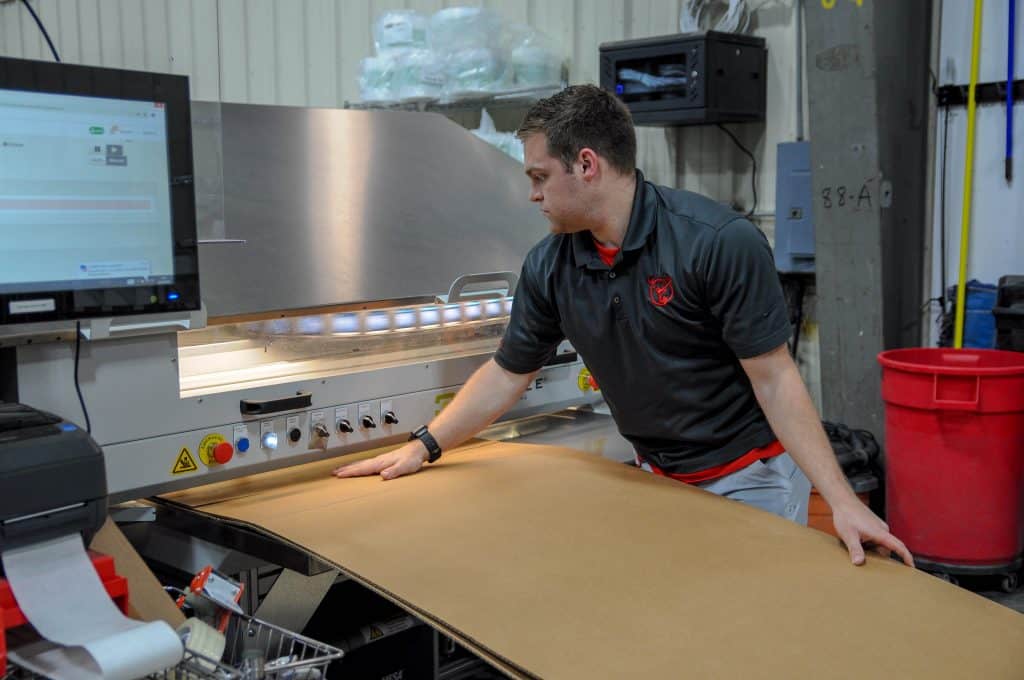
A custom box can go beyond a logo or design on the outside. There are experts who can help your business achieve a one-of-a-kind experience for your customers.
FastKit is a great example of a high-end company that will deliver a high-end custom masterpiece. It’s worked with some big names (Domino’s, Swiffer, and Marvel, to name a few).
The best part about these custom options is that they’re more accessible than ever before. You don’t have to break your first million before you invest in custom packaging. You can give your customers a high-end experience without a high-end cost.
Services like Packhelp let you design your own packaging elements. These companies also allow you to view a 3D image of the final product. Websites like Cratejoy are excellent places for packaging for subscription box-based online businesses. A custom package may become even more important if you’re selling a monthly subscription box.

Tape options for ecommerce packages
Tape may seem like the least exciting part of ecommerce packaging but it’s a key to packaging success. If you ship your orders in boxes, packing tape is literally the glue that holds it all together.
Basic clear acrylic tape is fine for boxes holding up to about 15 pounds. It’s inexpensive and, with a good tape dispenser, easy to use.

Water-activated tape is a better option for a more durable, professional look. Reinforced, water-activated Kraft tape provides a strong seal that will hold together packages of 25 pounds or more. If you choose this option, you’ll need a dispenser to wet the tape.
Infill options for ecommerce packages
When you ship products in a box, in most cases you need to add infill to keep them from moving around during shipping. Infill adds extra padding and stability to ensure your orders arrive undamaged.
There are many types of infill to choose from. Amazon, one of the largest shippers in the world, uses a combination of air-filled pillows and brown paper. There’s no one-size-fits-all answer to infill. You’ll need to strategize based on your specific product and shipping.
You may decide, like Amazon, to use more than one type of infill to protect your products during shipping. Again, the many infill options ensure you’ll be able to find a broad range of eco-friendly fillers on the market.
Test any option in real-world scenarios to ensure it adequately protects goods. Shipping multiple products to a customer—with all the driving, packaging, and more—is typically less environmentally friendly because it uses more gas, materials, and space.
Kraft paper
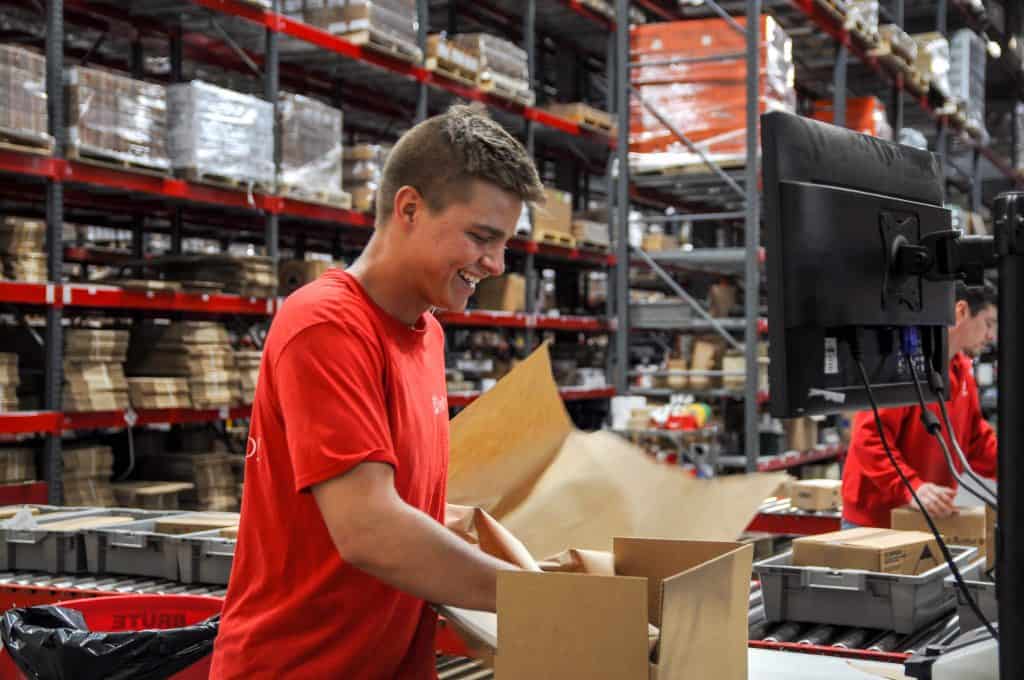
Brown Kraft paper is one of the most versatile and flexible types of package infill. You can easily rip it into whatever size sheets you need or crumple it to fit any infill need. Kraft paper is also completely recyclable. It takes less chemical input to make Kraft paper than to make bleached white paper products. As a bonus, you can source Kraft made from recycled paper.
Air pillows
Air pillows are the air-filled plastic sacks that are an increasingly common type of infill. They are one of the lightest forms of packaging infill. If you’re concerned about the weight of your package and need a lot of infill, air pillows may be the most affordable choice. They can be recycled under some circumstances, but it’s a safe bet that most of them end up in the landfill.
Packing peanuts
Peanuts are the classic infill but can be messy and frustrating to work with, transport, or receive. The original Styrofoam peanuts are feather-light—but that’s part of the problem. They tend to escape the box and float away. This can cause problems on both the packing and receiving end.
Styrofoam is not recyclable, and many cities and states have outlawed the use of Styrofoam peanuts.
Packing peanuts made from cornstarch are much more ecologically friendly and easier to dispose of. They can even be composted or dissolved in water. However, the individual peanuts still tend to float around. Most customers consider either kind of packing peanuts a nuisance. Think carefully before using them.
Bubble wrap

Bubble wrap is great for wrapping delicate items. It’s also fun to pop the bubbles. Your customers may consider bubble wrap infill a bonus treat.
It may be worth telling your customers that many collection points for recycling plastic bags will now also take bubble wrap, giving the customer a chance to enjoy the pop and then toss it in a safe, eco-friendly way.
Foam wrap
Foam wrap is an alternative to bubble wrap for wrapping fragile products. The fact that it is thin, light, and easy to work with makes foam wrap appealing. Unfortunately, this product is not recyclable and can create environmental problems. Fortunately, innovations in infill give you excellent green alternatives.
Shredded cardboard
Shredded cardboard infill is a great way to recycle and wrap at the same time. All you need is a machine that turns old cardboard into accordion-like sheets. These sheets can securely wrap around fragile items to protect them during shipping. This choice is the ultimate in eco-friendly packaging. On the receiving end, it’s easy for customers to remove and recycle.

Branding opportunities for ecommerce packaging
Packaging isn’t just about the materials you use to safely deliver your orders to your customers. What you put inside the box, in addition to the products, can make a big impression. Think of it as the physical manifestation of your brand voice.
Here are some items to consider as you figure out what you want to ship with each order.
Receipts
The receipt is a surprisingly important component of the packaging experience. Your customers expect an itemized receipt for the order, but it often gets forgotten.
But don’t just include a receipt; make it memorable. Custom stickers, stamps, and even a handwritten “thank you” can turn a standard receipt into a branding and customer experience opportunity.
Whatever you choose, ensure it fits with and furthers your overall branding. With a little creativity, your receipt can complement your order.
Rewards
The perfect place to further your branding efforts and encourage loyalty is in the box. Your next sale starts when your customer opens their order.
Include a coupon with a unique discount code for additional purchases within a certain amount of time. Or add an invite to a loyalty-based rewards program or early access to an upcoming product launch.
Tissue paper
Tissue paper is delicate, and we associate it with gifts. Wrapping your products in tissue paper will impart a sense of luxury and fun to the customer. Tissue paper boosts the perception of quality and can also help reinforce your branding.
Use solid, on-brand colors, or get custom-printed tissue. Companies like DigiWrap and NoIssue sell both options.
Stickers
One of the easiest and most budget-friendly options for in-box branding is stickers. Use them to secure tissue paper around the product inside or decorate the outside of the box or the carrier bag. You can also include a few extra stickers as a free gift, which will give you free advertising.
There’s a plethora of custom design tools and websites that allow you to print stickers in any color, shape, and size you want.
Uprinting, VistaPrint, and Moo are good places to start. If you’ve never used custom printing or packaging for your products, custom stickers are an inexpensive way to try it out.
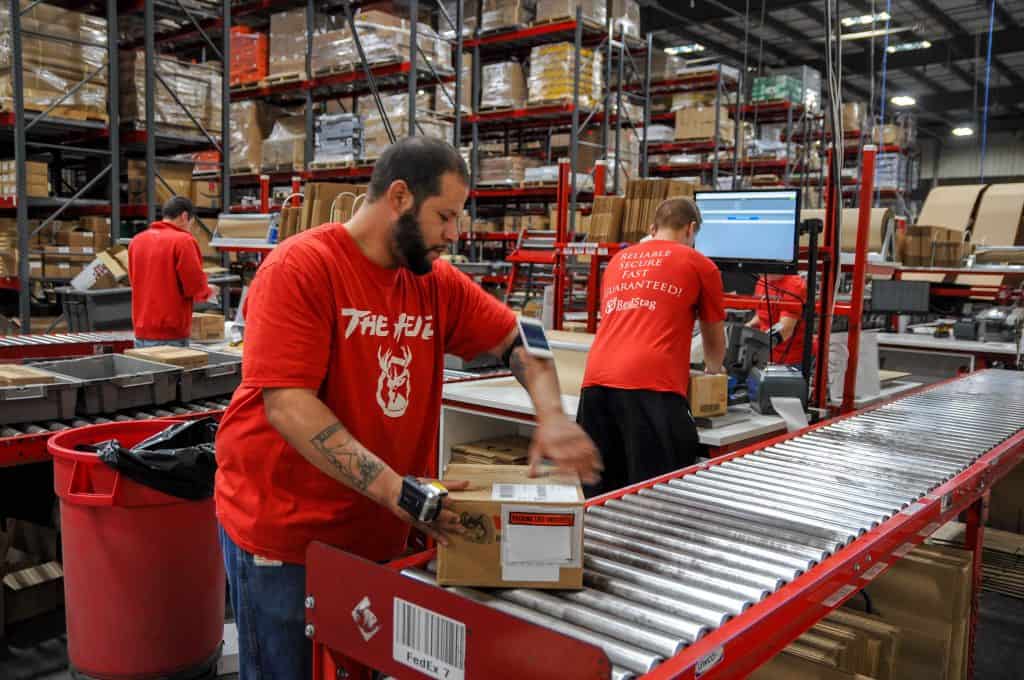
What does your packaging say about your products?
Every aspect of your packaging, from the box or envelope to the tape and infill, conveys a message. On the most basic level, a well-packed box tells your customers you take the time to ship their orders carefully. The extra touches you add help build your brand and boost customer loyalty.
If you outsource your fulfillment, you can turn to your fulfillment company for expert advice about ecommerce packaging. Test your order fulfillment company by having orders shipped to yourself. This way, you can better understand your customer’s unboxing experience.
Don’t view your packaging and infill as static. Keep improving your packaging process and materials.
As your business grows, you may want to upgrade the look and feel of your ecommerce stores and orders. And, as packaging materials and techniques evolve, you will be able to choose from newer, greener, and more appealing packaging and infill options.
Ask how we’d package your goods in an eco-friendly way.
This article was originally published in August 2019, and was updated on April 3, 2024 to reflect current packaging trends and Red Stag Fulfillment support.






